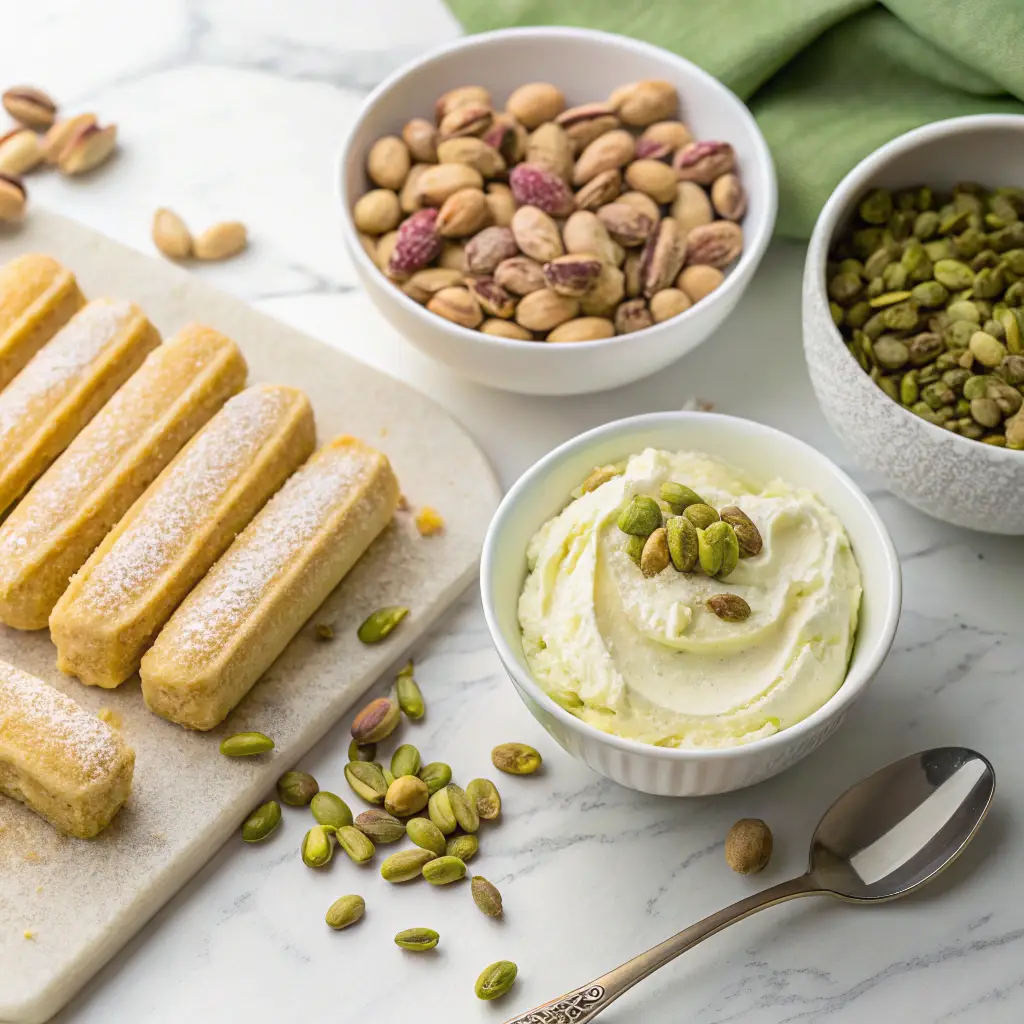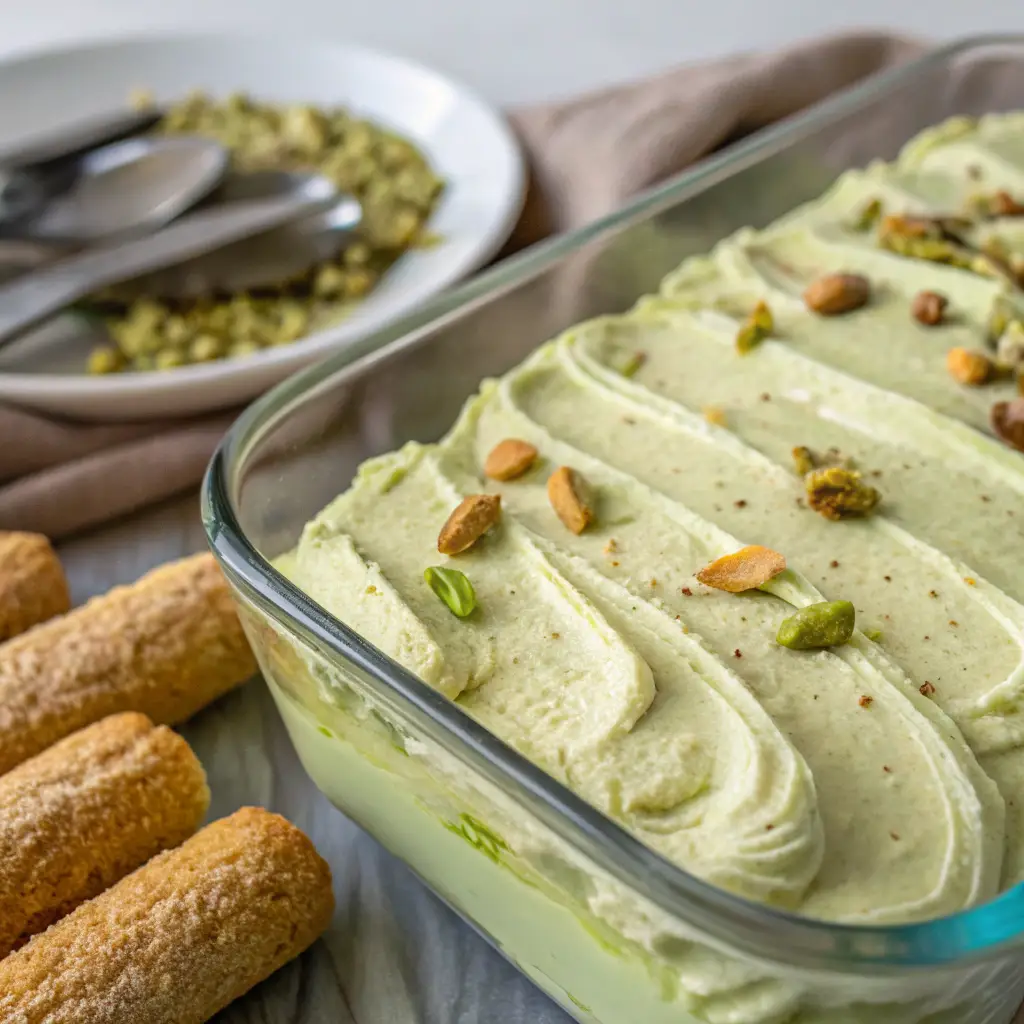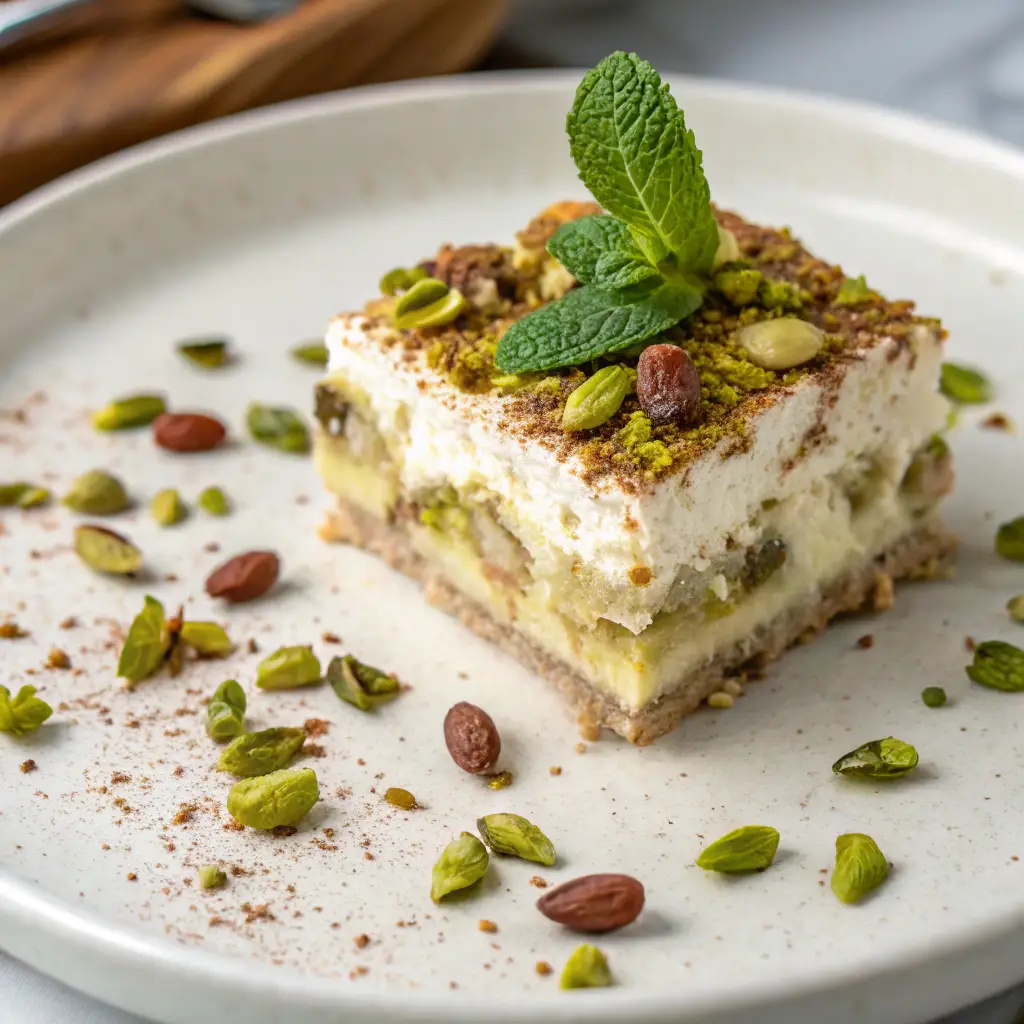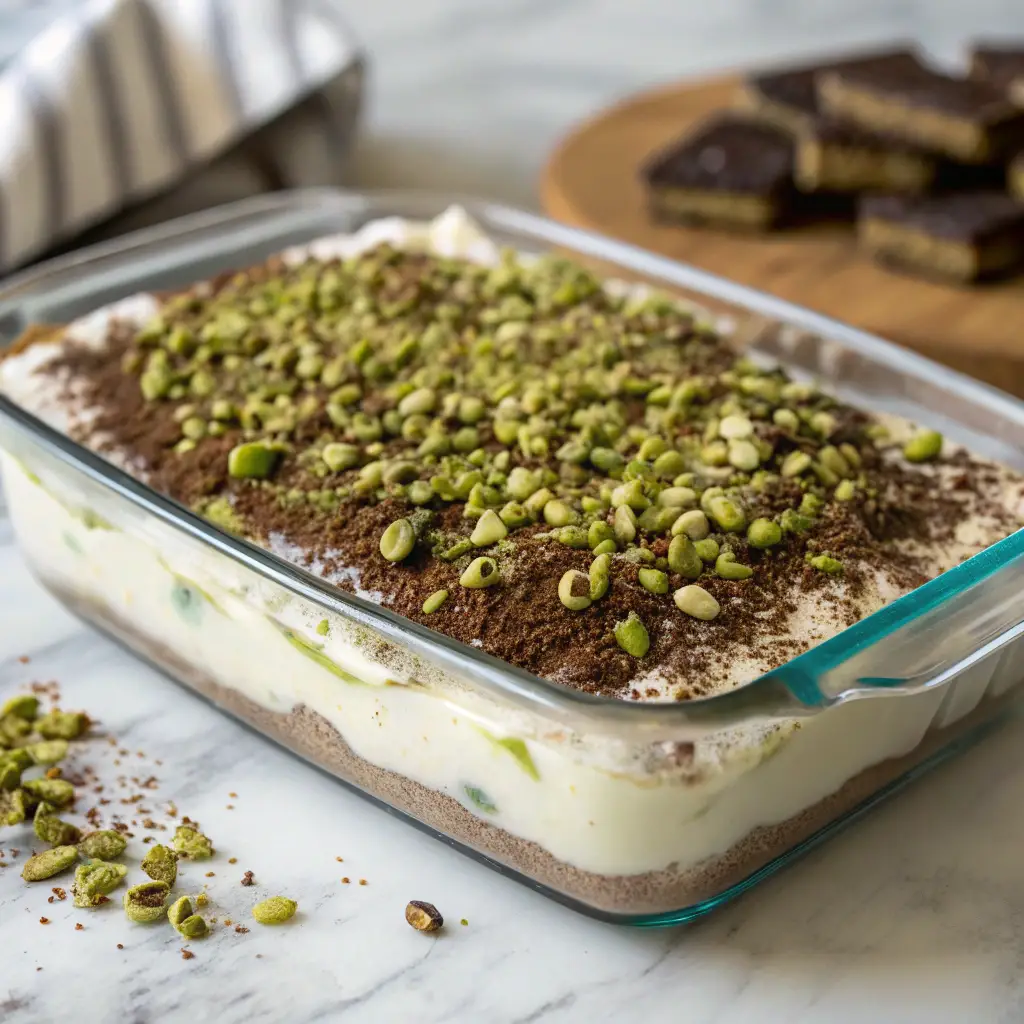Tiramisu is already a beloved classic, but when you infuse it with the rich, earthy flavor of pistachios—pure dessert magic happens. Pistachio tiramisu elevates the traditional Italian favorite into something even more indulgent, colorful, and unforgettable. Whether you’re a die-hard tiramisu fan or just someone who loves nutty desserts, this twist will capture your attention and your taste buds.
In this article, we’ll dive into everything you need to know about pistachio tiramisu. We’ll cover how it differs from the traditional recipe, the key ingredients that make it pop, and walk through the step-by-step process to create it at home. You’ll also discover expert tips to avoid common mistakes, whether or not it can be frozen, and fun variations to try.
By the time you’re done reading, you’ll be more than ready to serve up your very own creamy, nutty slice of heaven. Let’s get started with the basics.
Table of Contents
PART 1: What Is Pistachio Tiramisu and Why Is It Special?
Introduction to Pistachio Tiramisu
Pistachio tiramisu is a delightful variation of the classic Italian dessert. Instead of the traditional cocoa and coffee notes dominating the flavor, pistachios add a nutty, slightly sweet twist that’s both luxurious and refreshing. This version typically replaces or enhances the mascarpone cream with pistachio paste or pistachio-flavored custard, giving the dessert a pale green hue and a distinct flavor profile.
How It Differs from Classic Tiramisu
The main difference lies in the flavor and texture. While traditional tiramisu leans on bold espresso and rich cocoa, pistachio tiramisu is more subtle, with a sweet nuttiness that pairs well with mascarpone. Some versions still use espresso-soaked ladyfingers, while others opt for a lighter syrup or pistachio milk soak to avoid overpowering the pistachio flavor. The result is a unique, no-bake treat that stands out at any gathering for both its taste and presentation.
PART 2: Key Ingredients for the Best Pistachio Tiramisu
High-Quality Pistachios: Raw vs Roasted

The foundation of an unforgettable pistachio tiramisu is, without a doubt, the pistachios. But not just any kind—go for fresh, unsalted pistachios, either raw or lightly roasted. Raw pistachios give a slightly sweet, more vibrant flavor, while roasted ones bring out deeper, nuttier notes. Avoid pre-salted or flavored versions—they can throw off the delicate balance of the dessert.
To maximize taste and texture, many recipes call for finely ground pistachios or a rich, smooth pistachio paste. Homemade paste is ideal and typically made by blending shelled pistachios with sugar and a splash of water or oil. The result? A natural green cream with intense flavor.
Choosing Mascarpone, Ladyfingers, and Pistachio Paste
Mascarpone cheese is the creamy backbone of tiramisu. It should be fresh, full-fat, and not overly tangy. For best results, avoid using substitutions like cream cheese—they just won’t give you the same luxurious mouthfeel.
Ladyfingers (savoiardi) serve as the structure of this no-bake dessert. Use crisp ones that can soak up espresso or flavored syrup without falling apart. For a pistachio-forward version, some people dip the ladyfingers in pistachio milk or a light sugar syrup instead of espresso.
If you’re not making your own pistachio paste, be sure to choose a high-quality brand with minimal added sugar or preservatives. A good paste should be thick, smooth, and a bright green color without added dyes.
Optional add-ins like chopped pistachios, a touch of white chocolate, or even a splash of amaretto can elevate the final flavor. However, keep it balanced—pistachio should be the star of this show.
PART 3: Traditional Tiramisu vs Pistachio Tiramisu
Layering Technique Comparison
In classic tiramisu, layers alternate between coffee-soaked ladyfingers and a whipped mascarpone filling, topped with cocoa powder. With pistachio tiramisu, the layering style remains mostly the same, but the flavors shift. Instead of bold espresso and dark cocoa, the layers in this version highlight a nutty pistachio filling, often colored naturally green and speckled with finely ground nuts for texture.
The ladyfingers may still get an espresso dip, but many recipes switch to pistachio milk, almond extract, or a mix of espresso and pistachio liqueur. This ensures the flavor complements rather than overwhelms the creamy pistachio layers.
Presentation also gets a twist—dusting the top with crushed pistachios or drizzling with pistachio cream makes it visually appealing and instantly recognizable as a unique take on the original.
Differences in Flavor and Presentation
Traditional tiramisu has a distinct bitterness from espresso and cocoa, balanced by sweet mascarpone and sugar. Pistachio tiramisu, in contrast, is milder and nuttier, often described as smoother and more dessert-like for those who prefer less bitterness.
In terms of color, traditional tiramisu is mostly tan with a dark top layer. Pistachio tiramisu, however, adds a soft green tint and a speckled nutty top, making it visually distinctive.
If you’re serving guests or looking to wow at a potluck, pistachio tiramisu offers a more colorful, gourmet-looking dessert that doesn’t sacrifice flavor for flair. It keeps the comfort of the original while adding a fun, modern twist.
PART 4: Step-by-Step Recipe: How to Make a Traditional Pistachio Tiramisu
Preparing the Pistachio Mascarpone Filling

Start by preparing the pistachio mascarpone cream. In a large bowl, whip together 16 oz of mascarpone cheese and 1/2 cup of pistachio paste. Add 1/4 cup powdered sugar and a splash of vanilla extract. In a separate bowl, whip 1 cup of heavy cream until stiff peaks form. Gently fold the whipped cream into the mascarpone mixture until smooth and airy.
For a richer flavor, some recipes include a small amount of white chocolate or almond extract in the mix. Be careful not to overmix—this can deflate the cream and make it runny.
Layering with Espresso-Dipped Ladyfingers
Dip ladyfingers one at a time into cooled espresso or a pistachio syrup (made from water, sugar, and pistachio extract). Let each soak for just a second—over-soaking will make them mushy.
In a glass or ceramic dish, spread a layer of the pistachio mascarpone cream. Add a layer of soaked ladyfingers. Repeat until all ingredients are used, finishing with a final layer of cream.
Top with a generous sprinkle of crushed pistachios and optionally dust with finely grated white chocolate or a little matcha powder for a color boost.
Refrigerate for at least 6 hours, or overnight, to allow the flavors to meld and the dessert to firm up. This step is crucial for a sliceable, set texture.
Check out common dessert prep tips in our are no bake cheesecakes any good guide to ensure flawless layering and flavor.
For more on traditional Italian tiramisu techniques, check out this in-depth guide from Giallo Zafferano
PART 5: Mistakes to Avoid When Making Tiramisu
Over-Soaking the Ladyfingers
One of the biggest missteps in any tiramisu recipe, including pistachio tiramisu, is over-soaking the ladyfingers. While it’s tempting to let them absorb as much liquid as possible, this causes them to fall apart and create a soggy mess. Dip each ladyfinger into espresso or syrup for no more than a second per side—quick in, quick out.
If you’re using a thinner soaking liquid like pistachio milk or liqueur, it’s even more crucial to reduce soak time. Oversaturation throws off the entire texture of your layers.
Using the Wrong Kind of Cream or Pistachio Paste
Many home cooks try to substitute mascarpone with cream cheese or whipped topping. That’s a shortcut you’ll regret. Mascarpone offers a rich, velvety texture that’s essential for tiramisu. Anything else will result in a flavor or texture that just doesn’t cut it.
Another mistake? Buying pistachio paste with added sugars, oils, or green coloring. Artificial pastes can make your tiramisu too sweet or taste synthetic. Stick with pure pistachio paste, or make your own for a truly authentic flavor.
Rushing the Chill Time
Pistachio tiramisu, like its classic cousin, needs several hours to chill—preferably overnight. Skipping this step prevents the flavors from melding and the dessert from setting properly. You want defined layers and a sliceable consistency, not a pudding pile.
Finally, avoid skipping the garnish. A light sprinkle of crushed pistachios or white chocolate on top not only boosts the flavor but makes the final dessert look irresistible.
PART 6: Can You Freeze Pistachio Tiramisu?
How to Freeze It Properly
Yes, you can freeze pistachio tiramisu, but it requires a few key steps to maintain texture and flavor. First, make sure your tiramisu is fully set—ideally chilled in the refrigerator for at least 6–8 hours. This helps it firm up before freezing.
Wrap the dish tightly with plastic wrap, followed by a layer of aluminum foil. If you’re freezing individual portions, place them in airtight containers or wrap each slice separately. Label with the date—it’s best to enjoy frozen tiramisu within 2 to 3 months.
If you’re prepping ahead for a special occasion, this method is perfect for saving time without sacrificing quality.
Best Thawing Method to Preserve Texture
To serve, move your frozen pistachio tiramisu from the freezer to the fridge and let it thaw overnight. Don’t microwave or thaw at room temperature, as this can lead to a mushy texture and separation in the cream layer.
After thawing, garnish with fresh crushed pistachios or a light dusting of powdered sugar to freshen up the look and add a touch of crunch.
It’s worth noting that while freezing works well, the mascarpone layer may lose a bit of its original creamy texture depending on the brand and recipe. If you’re serving it for guests, you might prefer to make it fresh, but for everyday enjoyment or prepping in bulk, freezing is a totally valid and convenient option.
PART 7: Variations and Flavor Twists
Adding White Chocolate or Nutella
Want to level up your pistachio tiramisu even more? Swirl in some white chocolate or Nutella into the mascarpone layer. White chocolate adds a creamy sweetness that complements pistachios beautifully, while Nutella adds a hazelnut-cocoa combo that creates a more decadent twist.
These additions don’t have to replace pistachio flavor—just use them sparingly. For example, melt 2–3 tablespoons of white chocolate and fold it into half of your mascarpone mixture. Or add a thin layer of Nutella between the ladyfingers and cream for a surprise bite.
Vegan or Dairy-Free Pistachio Tiramisu
Going plant-based? No problem. You can create a dairy-free pistachio tiramisu using coconut cream in place of mascarpone and non-dairy milk for the soaking liquid. Use vegan ladyfingers or sponge cake and opt for a vegan pistachio paste (check the ingredients to avoid added dairy or honey).
Cashew cream is another great alternative. Soak cashews overnight, then blend with pistachio paste, maple syrup, and vanilla extract to create a creamy, tangy layer that mimics mascarpone.
Boozy Versions or Mini Trifles
Add a splash of pistachio liqueur, amaretto, or white rum to your soaking liquid for an adults-only version that brings complexity and a warming aftertaste. Or, ditch the large dish altogether and build your tiramisu in mini jars or dessert glasses. These individual pistachio tiramisus are great for parties and look stunning topped with whipped cream and chopped nuts.
No matter which version you try, the pistachio twist keeps the dessert interesting while allowing you to play with creative flavors that suit your style.
PART 8: How to Serve and Store Pistachio Tiramisu
Serving Tips: Temperature, Toppings, and More

Pistachio tiramisu is best served chilled, but not ice-cold. Take it out of the fridge about 10–15 minutes before serving to let the cream slightly soften—it enhances both the flavor and texture. Use a sharp knife to slice clean portions, and wipe between cuts for the most beautiful presentation.
Top it with a dusting of finely chopped pistachios, a few whole nuts, or even a drizzle of melted white chocolate or pistachio cream. Fresh mint leaves or a sprinkle of edible flowers can make it truly picture-perfect for special occasions.
Want to get fancy? Serve it in dessert cups or martini glasses for a more elegant twist. Individual servings also help with portion control and presentation.
Shelf Life and Fridge Storage
In the refrigerator, pistachio tiramisu stays fresh for up to 4 days. Always keep it tightly covered to prevent the creamy layers from drying out or absorbing other fridge odors. Plastic wrap, a sealed container, or a glass baking dish with a lid works well.
If you’ve made a large batch, consider freezing half as described earlier. Just remember: freezing is great for texture preservation, but for that signature creaminess, freshly made is best.
For meal-preppers and dessert lovers alike, this dish hits all the marks—easy to make ahead, no baking required, and impressive enough to serve to guests.
PART 9: Pairing Pistachio Tiramisu with Other Desserts
Best Drinks to Serve With It
Pairing your pistachio tiramisu with the right drink elevates the whole dessert experience. For a classic Italian finish, go with a shot of espresso or a cup of strong coffee. The bitterness contrasts beautifully with the sweet, nutty cream.
For those who enjoy dessert wines, a chilled glass of Moscato or Vin Santo complements the pistachio flavors and brings a luxurious touch. Prefer something lighter? Green tea or chamomile tea also works well, balancing the richness without overpowering it.
Perfect Dessert Pairings
Want to create a full dessert spread? Pair pistachio tiramisu with small, complementary treats like almond biscotti, white chocolate-dipped cookies, or fruit-based desserts like a lemon tart or berry compote. These lighter items help balance out the richness of tiramisu.
If you’re going for a themed table, add other pistachio-based desserts—think pistachio gelato or pistachio panna cotta. The layered green and cream tones create a stunning display for holidays, weddings, or dinner parties.
And don’t forget—pistachio tiramisu also works as the standout dish in a buffet-style dessert bar. Just slice, serve, and watch your guests come back for seconds.
FAQs
What not to do when making tiramisu?
Avoid soaking ladyfingers too long—they’ll turn mushy and ruin the layers. Don’t skip chill time either; tiramisu needs hours to set. Also, steer clear of substitutions like cream cheese for mascarpone, and never use flavored pistachio paste with artificial coloring—it ruins the flavor.
How to make a traditional tiramisu?
Traditional tiramisu layers espresso-soaked ladyfingers with mascarpone cream made from mascarpone cheese, egg yolks, and sugar. Each layer is repeated and dusted with cocoa powder. The dessert is chilled overnight for best flavor and texture. Some versions add coffee liqueur or rum to the soak for extra depth.
Can you freeze pistachio tiramisu?
Yes, you can freeze it. Once fully chilled and set, wrap tightly and freeze for up to 2–3 months. Thaw overnight in the fridge for best results. Freezing individual portions also works great if you want to serve it over time without affecting the texture.
Conclusion
Whether you’re new to tiramisu or a long-time fan, pistachio tiramisu offers an elegant twist that’s hard to resist. With its creamy layers, nutty flavor, and stunning presentation, it’s the perfect dessert for dinner parties, holidays, or anytime you want to impress.
From choosing the right pistachios to layering techniques and freezing tips, you now have everything you need to make this Italian classic with a nutty upgrade. Keep it traditional or explore boozy, vegan, or mini versions—the possibilities are deliciously endless.
Don’t miss our strawberry cheesecake bars for another creamy no-bake treat to round out your dessert menu.

